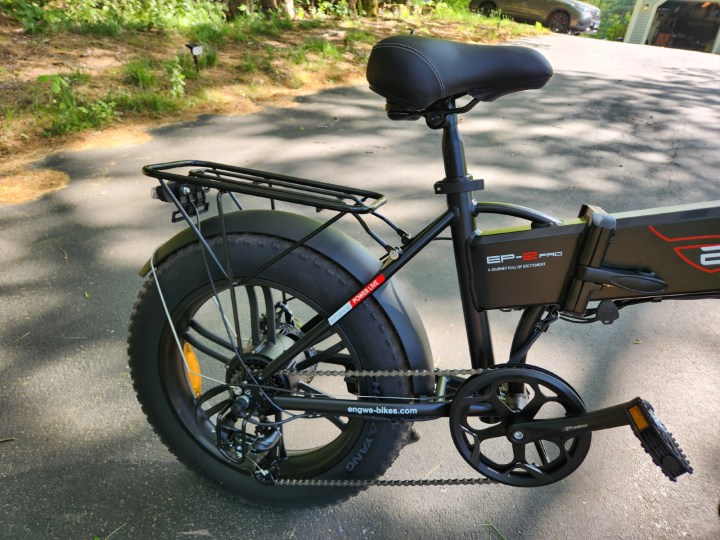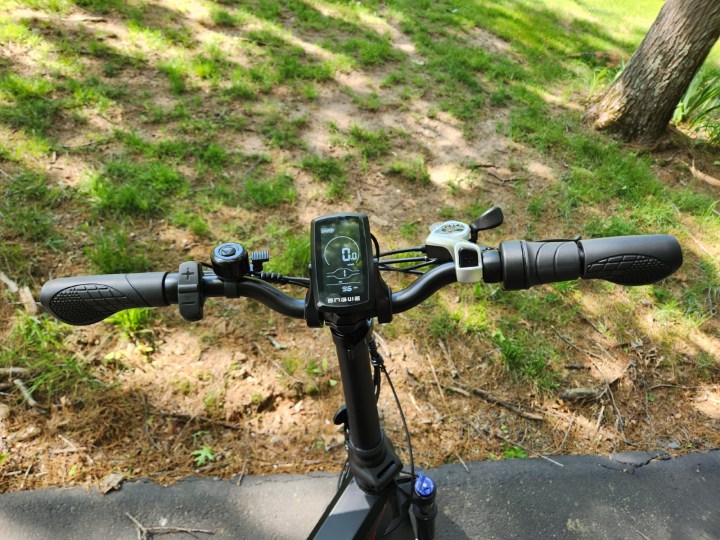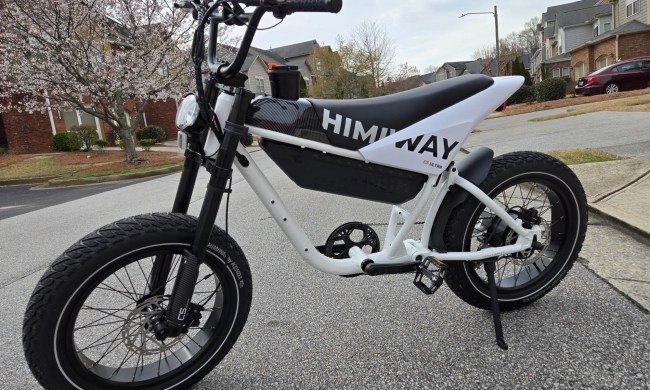
- Great value
- Fat tires handle any terrain
- Powerful motor
- Folds down to travel
- Lacks mirrors and turn signals
- Folding has a learning curve
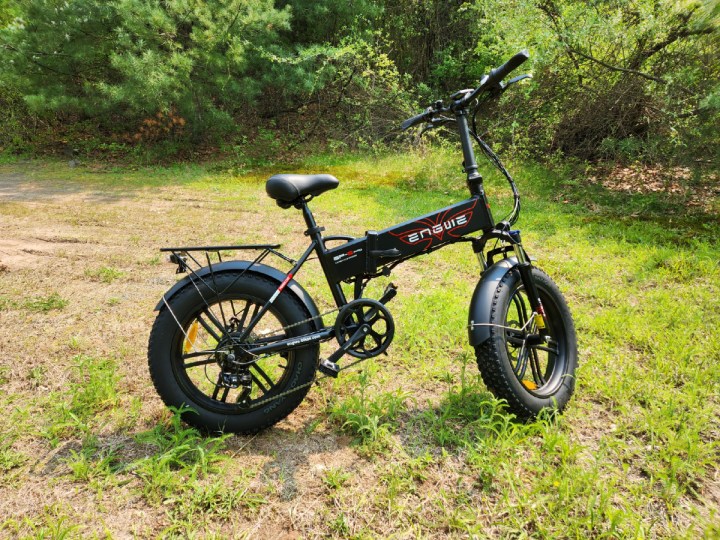
Why buy a folding e-bike? E-bike ads depict riders tooling along on beaches, mountain trails, and city streets, so who cares if the two-wheeler folds? The answers are transport, convenience, and independence. If you want to ride in places that aren’t close to home, a folding e-bike can be the answer to a question you didn’t think to ask. The Engwe EP-2 Pro e-bike is a surprisingly capable, well-equipped e-bike that folds into a compact size to fit in the back of your car, truck, or SUV. You can take the EP-2 Pro anywhere, and the $1,100 price is right.
Ready to ride
The EP-2 Pro arrives fully equipped with a ton of standard accessories, including some that are often missing on models that cost more. It comes standard with front and rear fenders, a kickstand, an LED front headlight, and a rear light that shines brighter when you touch the brakes. There’s also a handy rear rack. The only items you may want to add are mirrors and turn signals if you plan on urban riding.
A shipping company delivers your Engwe EP-2 Pro from the company’s California-based warehouse in a large 81-pound box. Inside you’ll find the mostly assembled e-bike, separate user manuals for the bike and electronic display, and tools to attach the front fender, LED headlight, front wheel, and pedals. After you slide the stems for the handlebar subassembly and nicely padded seat into their respective posts, it’s easy to adjust both to your height preferences. All cables and wires that attach to the handlebar are preinstalled and neatly organized and wrapped. Loose cables can flop around and look messy, but that’s not a problem with the EP-2 Pro.
One size fits nearly everyone
Because of the e-bike’s height adjustable seat and handlebar, Engwe claims the EP-2 Pro is suitable for riders ranging from five feet two inches to six feet eight inches. The EP-2 Pro’s total carrying capacity — rider and cargo — is 330 pounds. In comparison, the latest version of Rad Power Bikes folding e-bike, the RadExpand 5, can carry up to 275 pounds for riders from 4 feet 10 inches to 5 feet 10 inches. The Aventon Sinch.2 folding e-bike fits riders from 4 feet 11 inches to 6 feet two inches with a maximum 300-pound load.
Fat tires let you ride anywhere
When I began testing e-bikes in 2017, I thought fat tires were best for beach cruising but otherwise an inefficient design choice that looked cool but added weight and mechanical resistance to the bikes. I was wrong, at least partially. Yes, fat tires pack more weight and resistance on your bike, but their width lets you ride on almost any road, trail, or ground surface, including loose sand and rocks.
The Engwe EP2-Pro’s 20-inch diameter, 4-inch wide tires have relatively tall sidewalls that can flex to smooth out your ride. I dropped the front and rear tire pressures from the 20 pounds per square inch (psi) maximum inflation to 15 psi.
The EP2-Pro has no rear suspension, but with the front suspension adjusted for maximum travel in unlocked mode, the tire flex, suspension travel, and soft but supportive seat add up to a reasonably comfortable ride. The Engwe EP2-Pro isn’t optimal for high-performance mountain trail riding, but the design compromises add up to an extremely capable e-bike for casual rides, exercise, and commuting.
Easy to operate
In addition to its go-nearly-everywhere versatility, the Engwe EP2-Pro e-bike is set up for simple operation. Once you set up the e-bike and adjust its seat and handlebar height, you can hop on and ride it without battery assistance.
The EP2-Pro weighs 68 pounds, about average for e-bikes. However, unlike most other electric bikes, I was surprised and pleased at how effortlessly I could pedal the Engwe without battery power. Riding up a steep incline can be a significant chore, but if you’re traveling on relatively flat roads or paths, you should find it possible to move along on muscle power only, using the Shimano 7-speed shifter to adjust pedaling effort and speed.
The e-bike’s mechanical disc brakes front and rear have plenty of stopping power when you’re riding with or without battery assistance. Unless you travel in predominantly hilly areas, riding the Engwe EP2-Pro with a depleted battery shouldn’t pose much of a challenge.
When you use the battery, the EP2-Pro has five electric assistance levels and three riding modes. The riding modes correspond to Class 1, 2, and 3 e-bike operation and speed limits allowed in most U.S. states. The default power setup mode conforms to Class 1, with electric power pedal assistance only with a 20-mile-per-hour (mph) maximum. A bright monochrome LED display shows your current power level, speed, distance traveled, and battery charge level.
Riding in throttle mode only, the EP2-Pro easily maintained 26 to 28 mph on paved roads.
The e-bike display has its own manual, but the type is so small I recommend downloading the online version from Engwe’s website so you can expand the font size. Using a combination of rubberized keys on the controller mounted on the left side of the handlebar you can enter comprehensive setup menus to change riding mode, top speed, and much more.
If you turn on throttle assistance in Class 2 mode, you can use the half-twist throttle control in the right handgrip by itself or with pedal assistance with the same 20 mph top speed. If you set up the EP2-Pro for Class 3 mode, you can also change the maximum speed to 28 mph, although Engwe recommends setting the limit to 25 mph.
Performance matters
Yes, it’s fast. The Engwe EP2-Pro’s power train consists of a 48-volt 13 mAh Lithium-ion battery and Engwe’s own in-house-developed electric hub motor. According to Engwe, the motor is rated at 750 watts of continuous power and 960 watts in burst mode, with 55 Newton meters (41 foot-pounds) of torque. Motor power levels allow you to sustain high speeds and torque helps you accelerate quickly and climb inclines.
When you ride bikes for pleasure, pulling up to a sliding stop is often a lot of fun and it was easy to control with the EP2-Pro.
Numbers are nice, but how they translate to real-life performance matter more. I weigh 165 pounds and tested the Engwe on all surfaces with the tire pressures set to 15 psi. Riding in throttle mode only, the EP2-Pro easily maintained 26 to 28 mph on paved roads. When I stood on the pedals while riding off-road on relatively flat surfaces I was more comfortable keeping the speed in the lower 20s.
I was impressed by the Engwe’s performance on hills. We have a longish driveway with an incline of more than 20 degrees. I was able to ride straight up the driveway from a standing stop without tacking back and forth to maintain momentum — a tactic I’ve needed with e-scooters. When I rode up our driveway from a moving start, the speed bled off just a bit.
Engwe rates the EP2-Pro at up to 75 miles range in pedal assist mode, depending on rider weight, speed, and terrain. If you use throttle power only, the maximum drops to 31 miles. As with all e-bikes, you should cut your expected range by one-third to one-half the manufacturer’s ratings, at least until you have experience with your bike’s actual performance. Recharging the EP2-Pro’s 13-amp-hour battery requires about four and a half hours. You can charge the battery installed in the bike or remove it to charge in your home.
A note about the EP2-Pro’s Wuxing mechanical disc brakes. Hydraulic disc brakes are more desirable than mechanical models because hydraulic models require less handgrip pressure. The EP2-Pro’s 160mm disc is also the minimum size you want on a 28-mph e-bike. In my testing, however, the Engwe’s brakes stopped the e-bike very quickly with minimal handgrip pressure. When you ride bikes for pleasure, pulling up to a sliding stop is often a lot of fun and it was easy to control with the EP2-Pro.
Fold, lift, and store
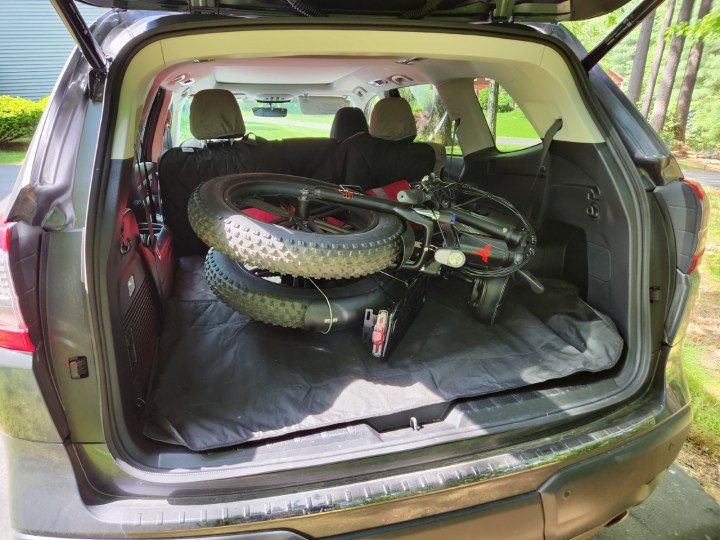
If you want to transport or store the Engwe EP2-Pro e-bike, you only need to fold it, lift, and place it where you want it. I found folding the Engwe had a slight learning curve but after a few practice tries it was quick and easy.
There are three steps to folding the EP2-Pro. First, loosen a single latch on the top crossbar to fold the e-bike roughly in half — this is also how you access the battery if you want to remove it. Next, unlatch and fold down the handlebar stem. Third, fold the foot pedals. When it’s folded, the EP2-Pro measures 39 inches long, 30 inches high, and 22 inches wide.
If you’re going to store the e-bike in a closet or under a counter or desk, you can roll it to position using the tires by holding the front of the folded bike off the floor. If you’re going to lift it into a vehicle or carry it upstairs, consider ahead of time that the Engwe weighs 68 pounds.
More for less
The Engwe EP2-Pro is an excellent value for a versatile e-bike suitable for most types of riding. Because it folds, the EP2-Pro is much less hassle to transport or store than non-folding e-bikes. There are two other folding e-bikes to consider, but they both cost significantly more than the Engwe EP2-Pro. The Rad Power Bikes RadExpand 5 fat tire folding bike has a convenient step-through frame, but it is rated for riders five feet and 10 inches tall or less, is limited to 20 mph, and costs $1,650. Aventon’s Sinch.2 is another step-through folding fat tire e-bike has torque-sensing pedal assist, but it also has a 20 mph speed limit and costs $1,800.
If you want a sturdy, easy-to-operate, and relatively comfortable e-bike that you can ride on all surfaces that’s also easy to transport without a truck, trailer, or hitch-mount carrier, the Engwe EP-2 Pro is a smart buy.

